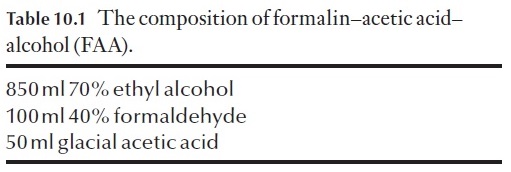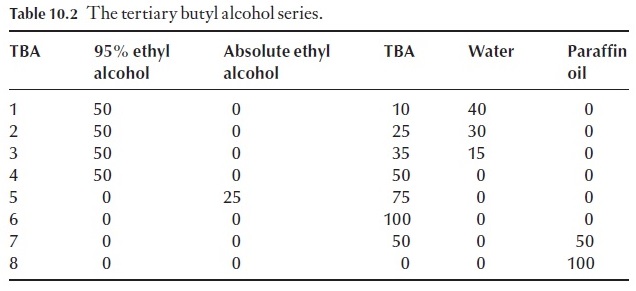Chapter: Plant Anatomy:An Applied Approach: Practical microtechnique
Dehydration and infiltration - Materials and methods in Practical microtechnique
Dehydration and infiltration
Pieces of thin leaf material are fixed and hardened in about 12 hours whereas thick leaves or small stems will require at least 24 hours. Woody twigs should be kept in FAA for about a week before continuing with processing. Note: Propionic acid may also be used, in which case the formula is desig-nated as FPA. Other well-known killing and fixing fluids are chromo-acetic and Flemming’s fixative, but these are potentially dangerous and should not be used by untrained people without proper supervision.
Dehydration is necessary in order to allow the material to be infiltrated with an appropriate supporting medium (paraffin wax; polyester wax or a polymer, such as glycol methacrylate) to provide adequate support for the material during sectioning. The fixing procedures involving the use of FAA and acrolein as the primary fixative differ slightly, and are described below.

This series of operations removes water from the fixed and hardened tis-sues. The removal of water is a necessary preliminary step to the infiltration of the specimen into a matrix that is not soluble in water. Complete removal of water ensures adhesion of the matrix to the external and internal surfaces of cells and tissues. The process consists of treating the tissue with a series of solutions which contain an increasing proportion of the dehydrating agent and progressively less water. Some anatomists regard tertiary butyl alcohol (TBA) as being an ideal dehydrating agent. The cost is high, but the results are well worth it!
Procedure for infi ltrating through a TBA series
The procedure which we recommend for infiltrating plant tissues through a TBA series is outlined in Table 10.2.
Begin infiltration in 50% liquid paraffin/50% wax after step 9, for 24 hours, and then followed by three changes of wax.

When the tissue has been infiltrated with paraffin wax in an embedding oven, the wax effectively supports the tissues. Infiltration consists of dis-solving the wax in the solvent containing the tissues, gradually increasing the concentration of the wax and decreasing the concentration of the sol-vent. This process is carried out in an embedding oven, usually at 50–70ºC, depending on the melting point of the wax used. After infiltration with wax as stated, the wax matrix serves to support the tissues against the impact of the knife. It is therefore very important that the infiltration procedure is carried out properly and carefully!
Procedure for fixing in acrolein
Warning: When following this method, please ensure that all waste is dis-posed of into designated, labelled waste containers. Do not discard down sink. Caution: Wear protective gloves and use a fume hood when work-ing with acrolein.
1 Cut small tissue segments into cold 10% acrolein – preferably in a Petri dish and on ice.
2 Put tissues in 10% acrolein into capped vials and leave at 0ºC for 24 hours in a refrigerator.
3 Dehydrate in 2-methoxyethanol and return to refrigerator at 0ºC for 12–24 hours.
4 Decant the 2-methoxyethanol carefully, and substitute with cold ethanol, n-propanol and n-butanol, in sequence, all at 0ºC for 12–24 hours each.
5 Transfer specimen into 25 : 75 n-butanol–paraplast wax chips. Place in an embedding oven for 12–24 hours which is set at temperature that is a few de-grees above the melting point of the wax. Do not cap the vials at this stage.
6 Decant mixture carefully, transfer to pure paraplast wax. Make three changes each of 12–24 hours each time.
When the tissue has been infiltrated with the paraplast in an embedding oven the wax effectively supports the tissues. Infiltration consists of dissolving the wax in the solvent containing the tissues, gradually increas-ing the concentration of the wax and decreasing the concentration of the solvent. This process is carried out in an embedding oven, usually at 50– 70ºC, depending on the melting point of the wax used. When infiltration![]()
![]() with wax is complete, the wax matrix serves to support the tissues against the impact of the knife. It is therefore very important that the infiltration procedure is carried out properly and carefully!
with wax is complete, the wax matrix serves to support the tissues against the impact of the knife. It is therefore very important that the infiltration procedure is carried out properly and carefully!
Mould the blocks and cut sections.
Related Topics